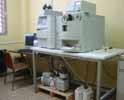| Chemical Characterization Techniques |
 |
| |
 |
 |
High Performance Liquid Chromatography (HPLC) Basic |
 |

High Performance Liquid Chromatography (HPLC) is an analytical technique for the separation and determination of organic and inorganic solutes in any samples especially biological, pharmaceutical, food, environmental, industrial, etc. A chemical separation technique based on the differential distribution of the constituents of a mixture between two phases, one of which moves relative to the other. In a liquid chromatographic process a liquid permeates through a porous solid stationary phase and elutes the solutes into a flow-through detector.
There are three main types of chromatography, categorized by the mobile phase type: gas (GC), liquid (LC), supercritical fluid (SFC). The majority of the HPLC separations are done with Reversed Phase separation.
In Reversed-phase chromatography (RPC) separations organic molecules are separated based on their degree of hydrophobicity. There is a correlation between the degree of lipophylicity and retention in the column. Uses hydrophobic packings phases bonded to silica or neutral polymeric beads. Types of Detectors:
- UV - Ultraviolet light (Absorbance detector: waters 5487 with double λ)
- MS - Mass Spec (Electrospray is the ionization techniques) WATERS ZQ
*Source: Zspray
Under atmospheric pressure it has the ability to analyze polar molecules which could be positive or negative charged in solution.
Only for soluble samples.
*Mass analyzer: quadrupole
High reproducibility and resolution (∆m=0.01 uma)
*Molecular weight operating range, up to 4000(m/z) |
|
 |
| |
 |
 |
Electrochemical Quartz Crystal Microbalance (EQCM) CH Instruments, 400 Model |
 |
The quartz crystal microbalance (QCM) is a variant of acoustic wave microsensors that are capable of ultrasensitive mass measurements. Under favorable conditions, a typical QCM can measure a mass change of 0.1-1 ng/cm2. QCM oscillates in a mechanically resonant shear mode under the influence of a high frequency AC electric field which is applied across the thickness of the crystal. QCM and the combination of QCM with electrochemistry (EQCM) have been widely employed for the determination of metals deposited onto the crystal, studies of ion-transport processes in polymer films, biosensor developments, and investigations of the kinetics of adsorption/desorption of adsorbate molecules. In EQCM experiments, the measurements of the various electrochemical parameters, such as potential, current and charge at the working electrode, and the acquisition of the corresponding frequency change, are conducted simultaneously. |
|
 |
|
 |
 |
| Physical Characterization Techniques |
 |
| |
 |
 |
Profilometer Ambios XP1 |
 |

An Ambios-Technology profilometer model XP-1, placed on a vibration isolation table.
Sample Stage Diameter:140mm
Scan Length Range: 30mm maximum
Sample Thickness: 20mm maximum
Vertical Resolution: 1Å at 10µm, 15Å at 100µm, 62Å at 400µm
Vertical Range: 400µm maximum
Magnification: 100X fixed objective with and attached CCD camera.
Stylus Tip Radius 2.0 microns
Stylus Force Range .05-10mg (programmable)
Scan Filtering Low-pass, high-pass, band-pass, and adjustable filter
The software performs calculation of surface roughness (Ra, Rq, Rp, Rv, Rt, Rz). |
|
 |
|
 |
 |
| Molecular Nanomagnetism Laboratory |
 |
|
 |
 |
|
|
|



